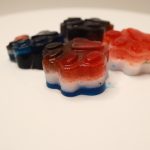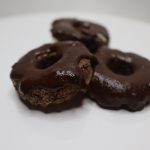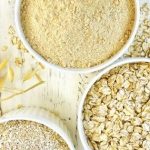What are Binders
Binders in dog treats are substances that hold your ingredients together to form the treat. For homemade dog treats, you should strive to use as many natural ingredients as possible.
In this article, we outline binders that you can try in your homemade dog treats to decide which suit your baking needs.
7 Good binders to use in your homemade dog treats
Let’s look at some healthy options you can use in your homemade dog treats.
1. Flours
There are a plethora of flours to choose from when baking for your little guy or girl, the choices seem endless. Let’s look at some healthy versions and why they work well.
Coconut Flour
Coconut flour is gluten-free, wheat free, and hypoallergenic. It is especially good for diabetic dogs or those that have high cholesterol.
It contains approximately 10% digestive carbohydrates but 40% fiber so is extremely beneficial for your dog’s digestive system. Fiber reduces the absorption of sugar into the bloodstream, so this is a great choice for diabetic dogs. It also ranks fairly low on the Glycemic Index which measures how much the flour raises your pet’s blood sugar levels.
Coconut flour has also been shown to lower cholesterol and removes toxins, therefore, improving digestive health. When cooking with it, you will most likely need to play around with amounts and liquid content as it tends to be more on the drier side.
The one con is price, as coconut flour is usually more expensive than other flour.
Chickpea Flour
Chickpea flour is gluten-free and made from plain or roasted dried and is a fairly good source of potassium, magnesium, and phosphorus.
It is a great source of folate as chickpeas contain seven times the amount of wheat flour. Chickpea flour is especially good for dogs that are pregnant or those at risk for folate deficiency.
Many times dogs with small-intestinal diseases or malabsorption (for instance in chronic pancreatitis sufferers) are low or deficient in folate.
Although, this is more common in cats as most dogs have small intestinal bacteria that can synthesize folate. You can always get your dog’s folate levels checked if this is a concern.
It is widely used in India where it is called gram flour or besan flour. It is very high in fiber and protein while low in carbs and calories. There are about 20 grams of protein in a cup of chickpea flour.
As with Coconut flour, you may want to play around with the amounts and use less chickpea flour than you would wheat as it is on the drier side.
Rice Flour
Rice flour is a good alternative as a binder, especially for dogs who may be sensitive to gluten and wheat products. It is made from long, medium, or short-grain rice. Since much of the rice we purchase today is made from GMO rice ensure that it is organic.
Rice flour may be useful in treats made for a pup that is just getting over an episode of diarrhea, as rice is one of the main staples of a bland diet. If you want to know twelve more foods that may help after a bout of diarrhea read our article 13 foods that can help if your dog has diarrhea.
This flour is really good in treats that are frozen or refrigerated since it inhibits liquid separation and the starchiness helps ingredients stick together well.
Want to read about the pros and cons of various flours for your dog? Click our article here!
2. Eggs
Organic eggs
Eggs are great binders due to their high fat and protein makeup (45.8 percent protein and 41.8 percent lipid). Plus adding them to your dog’s treats from time to time makes for a healthy snack.
They are high in protein, vitamins, amino acids, riboflavin, selenium, folate, and fatty acids and the shells can even be used as a good source of calcium (though they shouldn’t be used as a substitute).
Just be sure to cook them, as raw egg whites can cause biotin deficiency with long-term use. This is due to the protein avidin which binds to biotin and prevents uptake and subsequent use in the body. In addition, dogs are at risk of contracting Salmonella although slightly less than the people who feed and handle raw eggs.
Flax & Chia ‘Eggs’
Flax and Chia Seeds both create a very viscous, sticky almost mucoid-like liquid when soaked in hot water. Once ready to use, the liquid should resemble an egg white, hence the names.
Flax and chia are both pretty healthy when given to dogs in moderation. They have tremendous amounts of fibers and needed fatty acids which are beneficial for your pup. If you are incorporating them into your dog’s diet, you’ll want to read about the dangers of feeding your dog chia and the six things to keep in mind when giving your dog flax seeds.
Mix 1 tablespoon of flax seed or Chia seeds with three tablespoons of hot water. You can use a little bit less water for chia seeds, just play with the ratio until it is the consistency you desire. You can make a large batch to store and store in the refrigerator in a covered container for up to two weeks
3. Oats
Oats have starch, which makes them tremendous binders as they help give structure to many foods that we eat today. Oats are a great alternative for dogs that may be sensitive to wheat or other grains.
In addition, they provide tremendous health benefits including linoleic acid which is an omega-6 fatty acid.
They are also a great source of fiber, help regulate blood sugar levels, and can help with some gastrointestinal problems in dogs. You can read more about that here.
One drawback is that they are quite absorbent which is why many times they are blended with another binder such as an egg in baking. Experiment with the oats in your recipes and see what works well for you and your pup.
4. Gelatin
Didn’t think that gelatin would make the list? Well, dogs can eat and benefit from gelatin.
It is actually a natural part of their diet as it’s an edible substance made from animal by-products like tendons, skin, bones, and cartilage. Your dog is probably already eating gelatin if they eat dry kibble or canned wet foods.
It has tremendous health benefits beyond giving your dog healthy skin and fur, it has even been touted as being able to prevent arthritis.
When adding gelatin to your treats you want to always use plain, unflavored, unsweetened (natural or artificial) gelatin as some foods that contain it can be extremely dangerous for your dogs.
Many of them have artificial sweeteners like xylitol that can cause serious complications and in some cases death in dogs.
The trick is not to use too much since dogs don’t seem to be fond of the texture.
5. Psyllium
Psyllium is a seed that is produced commercially mostly for use as a dietary fiber and is also known as Metamucil to many. When combined with water, psyllium husk becomes mucilaginous and can expand up to 10 times its original size.
The chemical makeup is similar to that of xanthan gum but it is safe for dogs to eat (in moderation).
To use psyllium in your dog treats you can make a psyllium ‘egg’ similar to the flax and chia eggs using a 1:3 ratio or you can add it directly to your dry ingredients. If adding it to dry ingredients make sure to let the mixture sit for 15-20 minutes to allow the psyllium to soak up moisture.
Purchase certified organic psyllium and remember that a little goes a long way.
6. Arrowroot Powder
Arrowroot is a powdery, starchy substance extracted from the root of a tropical plant known as Maranta arundinacea. It is vegan and naturally grain-free, gluten-free, fat-free, and low in calories.
It is pretty high in vitamin B6 and potassium. It has been said to be able to alleviate diarrhea, constipation, and even an upset stomach.
Moderate amounts can be safely given to your dog, everything in moderation.
7. Bananas
Dogs love bananas and if you’re making them homemade dog treats try using them as a binder. Use them sparingly because bananas, especially when ripe, have a tremendous amount of sugar.

3 Average binders to use in your dog’s homemade treats
These are great binders in pet food and while they are generally safe for most dogs. If you have a dog with chronic disease or allergy you may want to think twice about using them as they can cause further issues in some pets.
1. Potato Starch
Potato starch is a great grain-free, binder and is already used in many dog foods on the shelves. But some recent concerns have led many pet owners to search for different options.
This is mainly due to the high glycemic index rating, so it is not the best binder for dogs with diabetes or those pet owners trying to control their pet’s intake of sugars.
Another reason this binder made it to the bad list is that although potatoes are packed with nutrients the potato starch lives up to its name as it is just that, starch.
2. Almond Flour
Almond flour is derived from almonds which are high in fat. Although a couple of almonds probably won’t do any harm to your dog, you may want to steer clear of using almond flour in their treats regularly.
If you have a pup with pancreatitis steer clear of using almond flour in their treats as the high-fat content can cause a pancreatitis relapse or gastrointestinal upset.
3. Wheat Gluten Flour
Wheat flour is one of the most commonly used flours in both human and animal treats. It contains gluten, which makes it an awesome binder and gives it that sticky, tacky feel. Not only is it great for joining and holding ingredients together, but it also has great moisture retention for moist treats.
Unfortunately, it can cause allergic reactions in some pets if they have wheat or gluten sensitivity. Each dog is different and what might cause one to have an upset stomach may not do the same for another. If you have been using wheat to bake your dog treats with no adverse reactions, by all means, carry on, but if not you may want to try some of the options mentioned earlier in the article.
2 Binders to never use in your homemade dog treats
1. Guar gum
Have you ever opened a can of dog food and noticed that it glistens and shines? That’s due to agents like guar gum and xanthan gum.
Although they have been shown to have some health benefits they can cause soft stools, gi upset, and bloating in your dog.
2. Bleached White flour
White flour is a pretty good binder but is usually treated by bleaching, either with chlorine or benzoyl peroxide (which is the same stuff used in facial acne creams). Needless to say, you should probably keep it out of your dog’s treats if not for that reason alone.
White flour has been linked with digestive issues in dogs. Some experts have stated that eating white flour can lead to inflammatory bowel syndrome or colitis in dogs.
As always speak with your veterinarian prior to making treats for your pet. They will be able to give you focused advice based on your pet’s specific needs.
What do you think of this list? Would you add anything to it? What is your favorite binder to use in your dog’s treats, let us know in the comments!

7 RULES OF THUMB WHEN MAKING YOUR DOGS TREATS
CHOOSING TREATS FOR YOUR DOG WITH A SENSITIVE STOMACH

























































































































